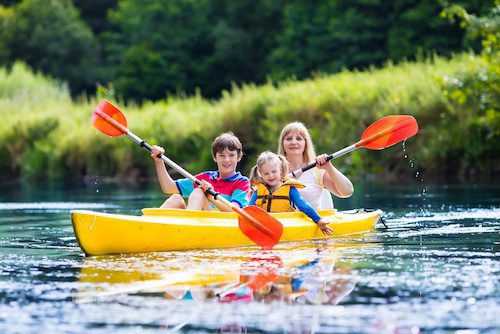
Kayaking is a beloved sport and hobby all around the world. If you have never done it, chances are you would have probably seen it. If you are just starting with kayaking, the first thing you need to learn is how to choose a kayak.
Like any other sport or outdoor activity, having the right equipment is a must. If you do not invest your time and effort in doing your research, you will end up dissatisfied. Here, we have all the details that you would need to know to make an informed decision.
Contents
How to Choose a Kayak
Kayaking is a challenging sport, so picking the perfect kayak is crucial. You need a kayak that can make it easier for you, instead of making it more difficult. The kayak must also meet your unique requirements. It must fit your height and kayaking style, or it may end up ruining your experience.
You might be slightly overwhelmed by the different types of kayaks you can choose from. Starting from the most general designs, you need to determine whether you want sit-in or sit-on-top kayaks.
Sit-in Kayak
Sit-in kayaks are traditional and are the most commonly available kayaks. Its unique quality is having a cockpit, which is an enclosed area where you may sit. Around this cockpit, there is a rim where you can attach a spray skirt to keep the water out.
There are many pros to buying a sit-in kayak. While it may not look very comfortable, it is very roomy inside. So, if you have a problem with confined spaces, there is no need to panic. There will be plenty of room, so your body is not cramped up.
This design also offers more storage space, which is great if you want to keep your valuables with you while out on the water. Additionally, most are designed with foot braces, making it more comfortable. It is the better option for efficient paddling because it has a lower center of gravity.
Sit-on-top Kayak
These are generally more user-friendly since they are very easy to get in and out of. This is because you will not feel like you are confined. Since the seating level is higher than usual kayaks, you will have no problems getting on and off.
Another great thing about this design is it is self-bailing, which means that they have small holes through which water leaks out. A sealed hull and molded depressions are also great qualities; these allow you to sail comfortably for a longer time.
Since these are versatile, these are perfect for you if you are a beginner. However, if the kayak sways too much, you can get splashed. For this reason, you should use this in hotter weather.

Size
Another thing to determine is the size of the kayak you want to buy. This is not only to make you feel comfortable to sit in it, but it also allows you to have easy paddling. The trick to this is choosing the correct paddle size for you.
While you may think it is merely just a matter of taking your height, it is not. You should take your upper body measurements and lower body measurements to pick out a correct paddling size for you. Just because you may be a certain height does not mean that the paddle will suit everyone that tall.
Also, keep in mind that the length of the kayak should ideally be longer, which would allow for more comfortable paddling. Since longer kayaks would require a longer paddle, this would give you the leverage of using the same paddle for all heights.
While longer and narrower options allow it to go faster in a straight line, you should see what is comfortable for you. If you are a beginner, a wider kayak may be the way to go because you cannot go at high speed, allowing you to get comfortable in the water first.
Durability
When you are buying a kayak, durability is going to be among your top priority. Kayaks come in different materials, weights, and prices to suit your liking. Plastic kayaks are the most commonly available kayaks found in the market.
Polyethylene kayaks are very popular because it has a longer shelf life. As it is also very light, these kayaks are portable and easy to carry. It also has a very high resistance to water, which is something you would want in your kayak. However, the downside is that it will warp in hot weather.
Fiberglass is also a common material used. This material is lightweight and rugged. Fiberglass kayaks are not only less likely to get damaged, but you can repair them easily if damages do occur.
Fiberglass also has reflectivity features, which means that it is unlikely to turn over in case it does face some obstacles in the water. The disadvantage of this material is the high price range, but if you are looking to invest in a good-quality kayak, this is the one for you.
Hull
The hull is very important when you are considering buying a kayak because it is the bottom of the boat. Once you choose a good hull, it makes a significant difference in your primary and performance stability.
There are many types of hulls, such as flat, rounded, V-shaped, pontoon, or chine. If you are looking for kayaks for recreational purposes, a flat hull or a pontoon would be ideal because they are quite stable. These two do, however, compromise on the speed, so that is one thing to look out for.
V-shaped and rounded hulls will be good options if you are in the market for some speed. They both vary depending on which you get, but generally, they will give you good speed.
Conclusion
While there are many things to consider when buying a kayak, it all truly comes down to what you want. Kayaks for sports and recreational rides do vary through their performance and build. It is about what would suit your needs and how you plan to use it.
We hope you find this guide on how to choose a kayak useful, and that you will be able to make a well-informed decision if and when you do decide to buy one.
